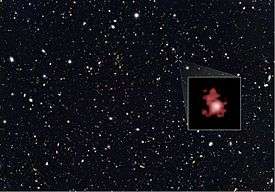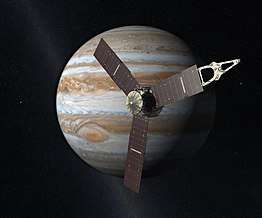HATS-11b
HATS-11b, also known as EPIC 216414930b, is a confirmed exoplanet, or exosolar planet, discovered in 2016 and has been described as similar to Jupiter.[1] It orbits the star HATS-11.
| Discovery | |
|---|---|
| Discovered by | HATNet Project |
| Discovery date | 2016 |
| primary transit | |
| Orbital characteristics | |
| 0.04614 AU | |
| Eccentricity | 0.34 |
| ~3.6 | |
| Inclination | 88.31 degrees |
| Physical characteristics | |
Mean radius | 1.51Rj |
| Mass | 0.85Mj |
| Temperature | 1637K |
Discovery
HATS-11b was discovered in 2016, using the primary transit method, by the Hungarian Automated Telescope Network (HATNet) in the HATSouth survey, which aims to discover exoplanets using the transit method. Since 2009 (when the HATSouth project began), 61 exoplanets have been discovered, as of 10th Feb 2020. The mass of HATS-11b was found using the radial velocity method.
Characteristics
HATS-11b has been described to be similar to Jupiter and orbits a subsolar metallicity star which is about 2955 light years away (906 parsecs). HATS-11b has an orbital period of around 3.6 Earth days and its temperature has been calculated to be 1637 Kelvin (1363.85 Celsius). HATS-11b has a mass of 0.85MJ and a radius of 1.49RJ. The planet's orbital eccentricity is <0.34 which means it has an elliptical orbit.[2][3]
Star
HATS-11b orbits around HATS-11. Compared to the Sun, HATS-11 is about the same mass and has a radius of 1.44 that of the sun. It is a type G0 star, meaning it is about medium heat. HATS-11 is very metal poor, it has a metallicity of around -3.09 Fe/H, meaning it has roughly one-thousandth the amount of metal than in the sun.[4] The star has an effective temperature of around 6060 Kelvin, which is 5786.85 Celsius, or 10448.33 Fahrenheit. HATS-11 is roughly 7.7 billion years old, much older than the Sun, which is 4.6 billion years old. HATS-11 has an apparent magnitude of 14, meaning it's quite dim as seen from Earth, and not visible with the naked eye.[5][6]
References
- Astrophysics Data System ui.adsabs.harvard.edu/abstract
- Astronomical Journal, Volume 152, Issue number 4, Article Number 88, Published Oct 2016
- https://www.semanticscholar.org/paper/AutoRegressive-Planet-Search
- ui.adsabs.harvard.edu/abstract
- The Extrasolar Planet Encyclopedia catalog HATS-11b
- simbad.u-strasbg.fr/simbad/HATS-11 Simbad data


